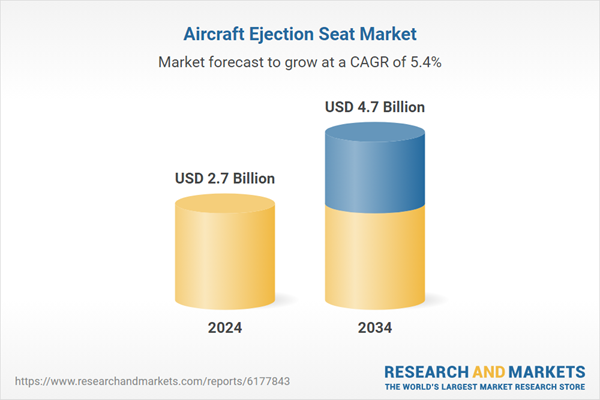The growth is driven by rising fighter jet procurement, ongoing upgrades of defense aircraft fleets, and advancements in pilot survival technologies. As global defense manufacturers move toward greater self-sufficiency, ejection seat systems have become a focal point in air combat safety innovation. With defense agencies prioritizing enhanced safety for pilots and mission-critical survivability in high-risk scenarios, the demand for technologically advanced and intelligent ejection solutions is gaining momentum. Rapid modernization initiatives and life-extension programs for aging airframes are further amplifying demand for retrofit-compatible, next-generation ejection seats. Defense players are also incorporating smarter systems with real-time sensor inputs to optimize timing and reduce injury risk during high-speed ejections. This convergence of innovation and strategy continues to shape the trajectory of ejection seat development worldwide.
The combat aircraft segment generated USD 1.8 billion in 2024, fueled by expanded defense budgets, modernization efforts, rising geopolitical uncertainty, and the global push for upgraded pilot protection solutions. There's rising interest in integrating lighter, modular, and more reliable ejection seat systems capable of interfacing with smart avionics and life-saving technologies. These systems are becoming integral to military aviation programs focused on rapid deployability and fleet longevity.
The single-seat segment generated USD 2.2 billion in 2024. Demand for single-seat systems is closely tied to the procurement of advanced frontline jets and sustained efforts to modernize global fighter fleets. The push for more compact, lightweight systems with enhanced durability and integrated health monitoring features is growing. This aligns with broader efforts to deliver scalable ejection solutions that can be seamlessly embedded into future fighter platforms, optimizing mission readiness and survivability.
U.S. Aircraft Ejection Seat Market reached USD 1.1 billion in 2024, supported by robust defense allocations, strategic air force upgrades, and growing investments in advanced ejection capabilities. Domestic manufacturers are prioritizing design innovations that enhance aircraft compatibility, material lightness, AI-driven decision systems, and improved post-ejection support infrastructure. The country’s expanding fleet modernization initiatives and emphasis on aircrew protection remain key contributors to sustained market momentum.
Leading companies involved in Aircraft Ejection Seat Market include Hindustan Aeronautics Limited, Collins Aerospace, AmSafe Bridport Ltd., Lockheed Martin, Northrop Grumman, Martin-Baker Aircraft Co. Ltd., Airborne Systems Inc., QinetiQ Group Plc, Parachute Laboratories Inc., Quickstep Technologies, Tencate Advanced Armor, RUAG Group, Safran SA, EDM Limited, BAE Systems, Butler Parachute Systems Inc., Survival Equipment Services Ltd., Vector Aerospace, Cobham Plc, and NPP Zvezda. To strengthen their presence, companies are focusing on lighter, modular ejection seat designs, improved sensor-based timing systems, and integrated smart safety technologies. Many players are expanding their retrofit offerings to support aging aircraft platforms while ensuring compliance with next-generation defense standards. Strategic collaborations with air forces and OEMs, continuous R&D investments, and strong aftermarket service capabilities are enabling these firms to gain a competitive edge.
Comprehensive Market Analysis and Forecast
- Industry trends, key growth drivers, challenges, future opportunities, and regulatory landscape
- Competitive landscape with Porter’s Five Forces and PESTEL analysis
- Market size, segmentation, and regional forecasts
- In-depth company profiles, business strategies, financial insights, and SWOT analysis
This product will be delivered within 2-4 business days.
Table of Contents
Companies Mentioned
The companies profiled in this Aircraft Ejection Seat market report include:- Martin-Baker Aircraft Co. Ltd.
- Collins Aerospace
- BAE Systems
- Lockheed Martin
- Northrop Grumman
- EDM Limited
- AmSafe Bridport Ltd.
- Quickstep Technologies
- Hindustan Aeronautics Limited
- NPP Zvezda
- Airborne Systems Inc.
- RUAG Group
- Safran SA
- Cobham Plc
- QinetiQ Group Plc
- Tencate Advanced Armor
- Vector Aerospace
- Survival Equipment Services Ltd.
- Butler Parachute Systems Inc.
- Parachute Laboratories Inc.
Table Information
| Report Attribute | Details |
|---|---|
| No. of Pages | 180 |
| Published | September 2025 |
| Forecast Period | 2024 - 2034 |
| Estimated Market Value ( USD | $ 2.7 Billion |
| Forecasted Market Value ( USD | $ 4.7 Billion |
| Compound Annual Growth Rate | 5.4% |
| Regions Covered | Global |
| No. of Companies Mentioned | 21 |









